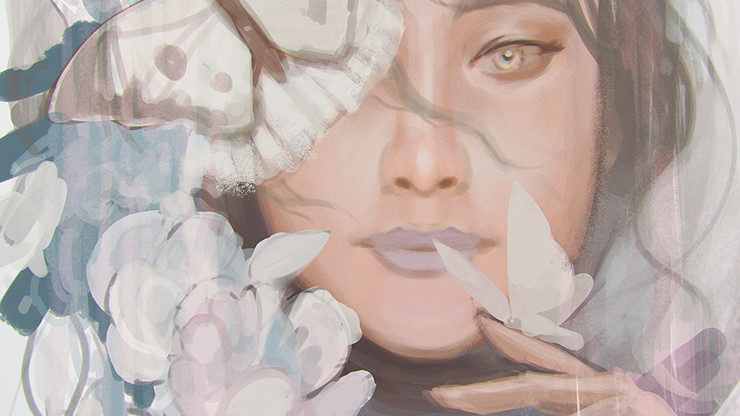Welcome back to Art of SFF—a column covering the best and brightest science fiction and fantasy artists. From newcomers to legends, Art of SFF pulls back the curtain to introduce you to the people behind your favourite book covers, films, and video games, and SFF-influenced art of all kinds. This time around, Jenn Ravenna joins us.
“My mother and father were immigrants who were always working overtime to support our family,” said Ravenna, a Seattle-based concept artist and illustrator who has worked for Wizards of the Coast, HarperCollins, XBOX, and Fantasy Flight Games, among many others. Science fiction and fantasy provide people in need of escapism with an opportunity for adventure, Ravenna said. They’re like a teleportation device to other worlds through various mediums—in art, books, video games, and film. “I had no siblings, so I was often left to my own devices. When I discovered science fiction in books and video games, I was immediately drawn to the endless possibility. It might sound sad, but it helped pass the time and make my world more interesting.”
The future of science fiction and fantasy art is bright and diverse, according to Ravenna. “I think we’re going to see more eastern art influence science fiction art in the coming years—influences like anime, video games, and eastern painters such as Ruan Jia. It will be interesting how that changes or complements the current landscape,” Ravenna said. “More and more I see this with Magic: The Gathering, which has seen more representation in its card illustrations. It’s pretty awesome.”
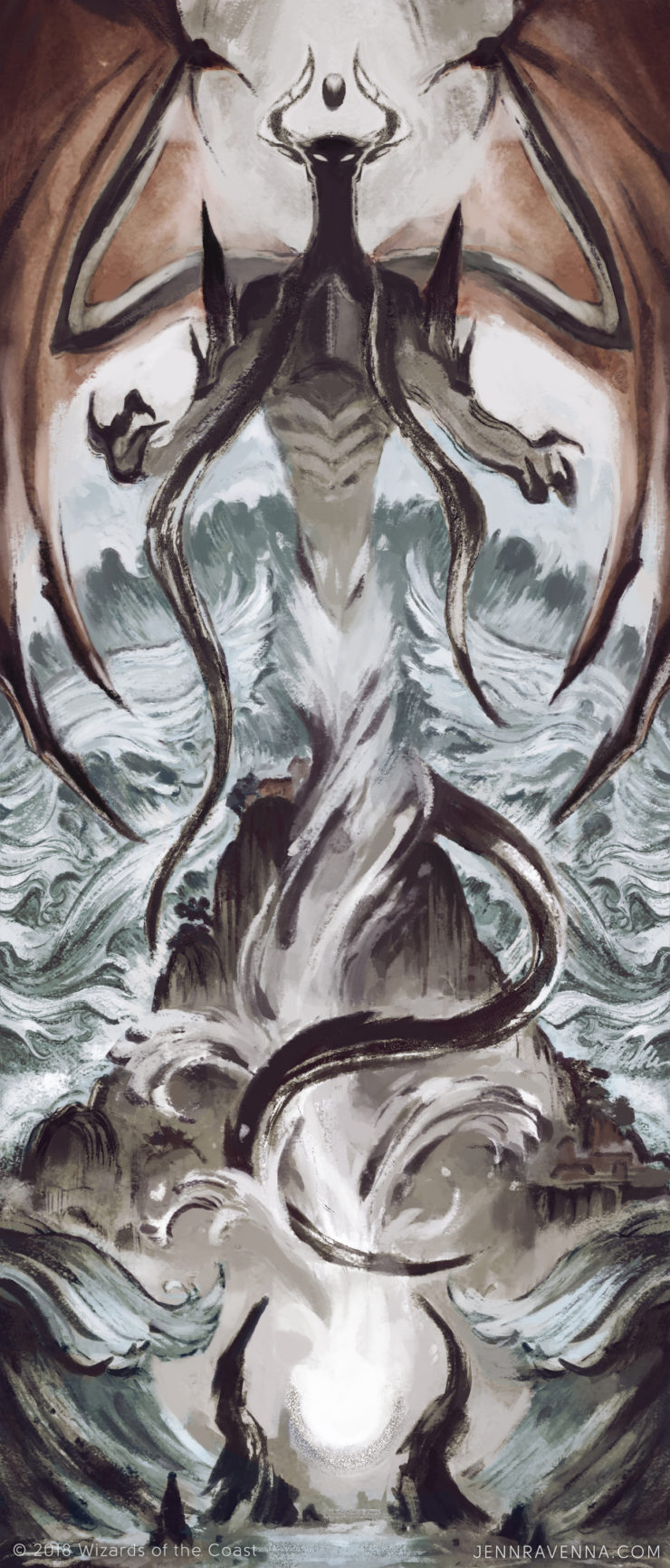
Though she didn’t play, Ravenna long admired Magic: The Gathering for the quality of its illustration and the way it tells a story through its cards. “When I was just starting out as an art student, and even still today, the quality bar of the art was something I aspired to reach. Painting such fantastical subject matters with a long and deep history of lore was very inspiring.”
That admiration turned into a professional connection the game when Ravenna landed an opportunity to illustrate a card for the long-running trading card game. Her stunning sumi-e ink painting of Nicol Bolas, a popular villain in Magic: The Gathering lore, has quickly become one of her most visible and popular pieces of art. Wizards of the Coast, notably through Magic and Dungeons & Dragons, are on the forefront of pushing forward a more diverse and inclusive visual representation of science fiction and fantasy’s broad boundaries. Through the art and storytelling in their games, they consistently provide a platform for artists from a wide-range of styles and backgrounds.
“The latest set, Dominaria, has some pretty badass female characters in these beautifully designed armor sets of different ethnicity and body types,” Ravenna said. “It’s really inspiring to see that kind of forward-thinking in high fantasy art.”
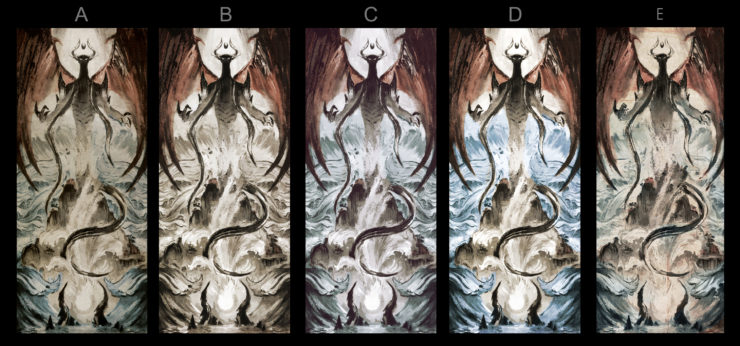
Ravenna worked hard alongside Dominaria’s art director, Mark Winters, to illustrate one of the set’s most visually arresting cards. “My experience with The Eldest Reborn was fun and rewarding,” Ravenna said. Getting the gig with Wizards of the Coast happened as the result of a combination of being prepared and getting lucky—one of those “right places at the right time” moments. “Mark was looking for someone who could do a commission in a sumi-e ink style. He asked the artists if they knew anyone who could do the style, and my friend Carmen Sinek (who is a fabulous person and artist) put my name in for the job. I sent Mark my stuff and he liked it enough to commission me! It was probably one of the most fun assignments I’ve had—to do an epic ink illustration of this iconic character for a dream [brand]. I feel incredibly lucky and honored to have been commissioned for this particular assignment.”
“The Eldest Reborn is a Saga, which represents a particular moment in the new set, Dominaria’s past,” Ravenna explained. This card type is new to Magic: The Gathering, so there was extra pressure to make them particularly memorable. First impressions count. “It represents an in-world artistic depiction of a historical event. This one was inspired by Japanese ink painting and woodblock prints. They were interested in the simplicity of sumi-e ink painting, but weren’t tied down to specific historical era or traditional, so I was able to work freely with that in mind in terms of styles and level of detail. My goal was to make an epic illustration depicting Bolas’ resurrection, honoring his character, sense of presence, and the mood, while trying to put as much detail as possible without sacrificing readability. It was challenging but incredibly fun.” She started by creating a handful of studies and thumbnails, which Winters chose from. “From there, we continued to iterate on the drawing—specifically on how we wanted Bolas to emerge from the Talon Gates. Color exploration came next (seen above), where I tried to emulate the limited palette of Japanese wood block prints. Then onto the final with adjustments. The feedback process was fluid and awesome. I hope to work on something like this again.”
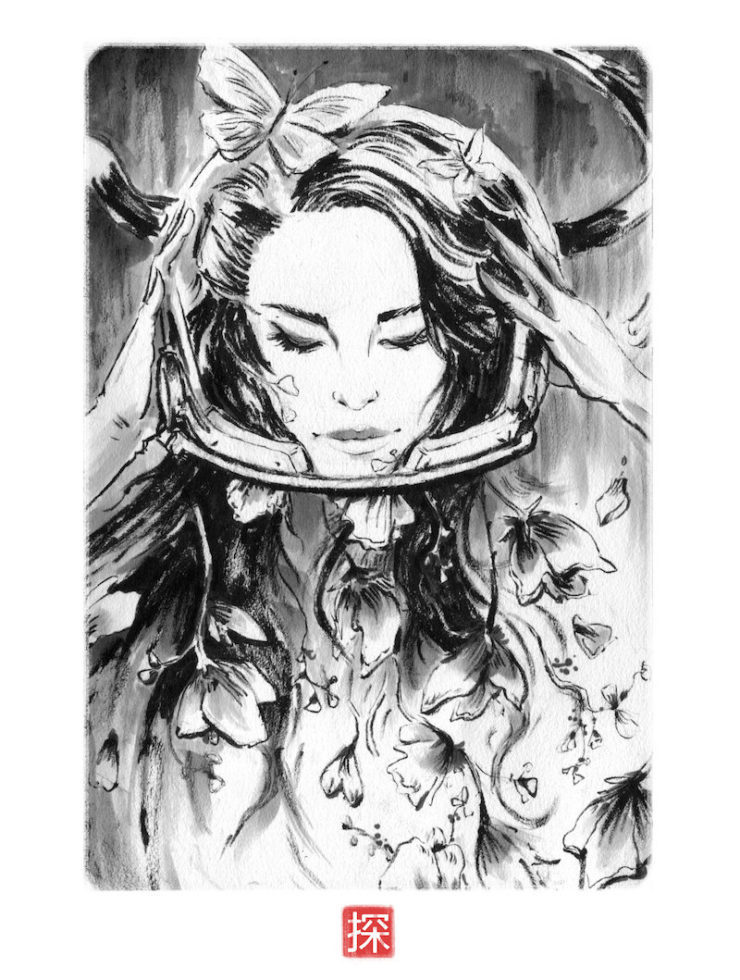
When it comes to personal work, Ravenna spends a lot of upfront time conceptualizing the end result. “I like to think about the image I want to create for myself, and figure out what type of aesthetic I want to hit. In concept art, it isn’t always about making a beautiful painting—a lot of the time it’s about problem solving and providing information for production teams to execute on. It can be more technical than glamorous. When creating something for myself I want to make sure it something I want to spend time on, something I can be proud of, while pushing my work as a whole.”
Alongside reading science fiction and fantasy, gaming was a big part of Ravenna’s youth, and helped create a strong bond with her father. “I would watch him play Gradius III on the Super Nintendo all the time. He would be the one to wait in line for the next new game console to come out. My cousins and I would play all sorts of Nintendo and Super Nintendo games—often Street Fighter II Turbo—or Pokemon on our Gameboys. I guess video games were a favorite pastime of my whole family. Thinking about it now, it’s pretty surreal to be working in an industry that was such a defining part of my childhood.”
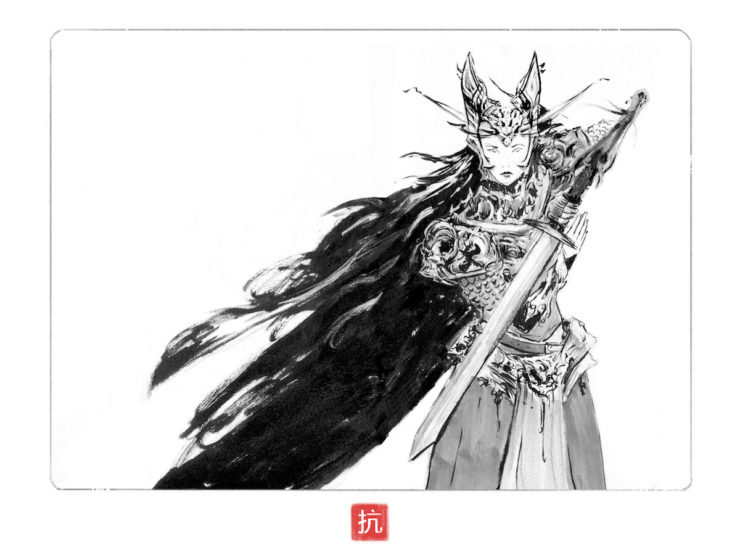
Speculative fiction helped her find her way in the world as a youth, and inspired her as an artist, but her career took her in a different direction at first. “My journey to get here was a weird one,” Ravenna admitted. She graduated with a Political Science and Human Rights degree, which set her on the path to law school. “I spent some time working as a legal clerk at a personal injury firm, working on heavy cases with sensitive material, and as an intern at the City of Seattle Attorney’s Office, processing misdemeanor cases.” While that work was meaningful, it didn’t fulfill her creatively. “That was important to me (even if I didn’t know it at the time). I wasn’t getting what I wanted out of my career/life.” So, after keeping a part time job as a web graphic designer, Ravenna went back to school—this time with the goal of becoming an artist in the thriving Pacific Northwest video game industry. “I landed my first internship two years into school, then quit school to save money and focus on the internship. I’ve been working in the industry ever since.”
With that goal in mind, Ravenna returned to her youthful admiration of video games, and began developing her style and process through a lot of trial and error. She would work tirelessly on emulating art styles until she was satisfied with the results. Working in the video game industry as a concept artist requires a particular approach, especially since so much of her work is client-based. “When it comes to a client, I try to give them exactly what they want,” she said. Sometimes that means compromising on my personal tastes and where I feel the art direction should go. One thing I’ve learned in recent years is to deliver options that match a client’s brief, then throw in extra stuff of your own that you might like better, and see what they think. Sometimes that works out to the benefit of both sides.”
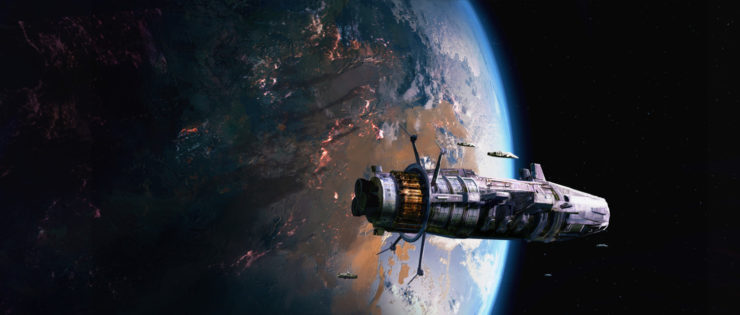
Properly targeting and evaluating the industry you’re working in and gauging your competition is vital, she said. Doing so helps you evaluate your work in a more objective and manner, influence the direction of your career, and help you learn what it takes to get noticed, to work consistently. Above-and-beyond that, Ravenna recommends that artists, especially aspiring artists, set aside time to work on personal projects. Experimenting and exploring is an important tool for artists to discover their personal style. “It’s hard to [do so] if you’re only doing client work—because you’re painting for other people, not yourself.”
Like her conceptual approach to client versus personal work, Ravenna’s process changes from project-to-project. And, it ain’t all fun and games, especially as concept artist for video games. “If it’s for my concept day job, depending on the time schedule, I might have to dive right into a brief to keep up with production schedules,” she said. “From my experience in games, sometimes there’s time for thumbnails and drawings, sometimes there’s only enough time to jump right into a piece with kitbashing. Sometimes it starts in 2D, sometimes it starts in 3D. It depends on the needs of the task and how to best offer a solution to a problem.”
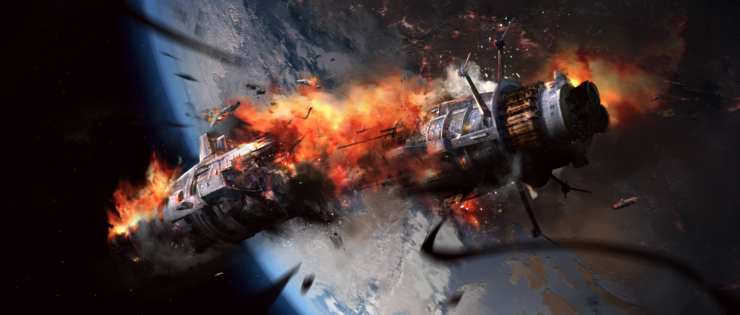
Freelance and personal work is a lot more flexible. “I can spend more time thinking about the brief before diving into research and sketching out thumbnails,” Ravenna said. “I was recently discussing process with a colleague, and he quoted—possibly from Syd Mead—that we don’t spend enough time thinking about a piece before we execute on it. Whether this is about the demands of a job or the demands of needing to produce new content for social media, I think that’s partially true. So for personal work, I’ll spend a long time thinking about a piece, go with what excites me the most, and start gathering references and inspiration before investing time into actually creating it.”
“Social media for artists means something different for everyone,” Ravenna told me. There’s no right way to do it. “Some people are more casual about it, others rely on it as a business strategy for their livelihood.”
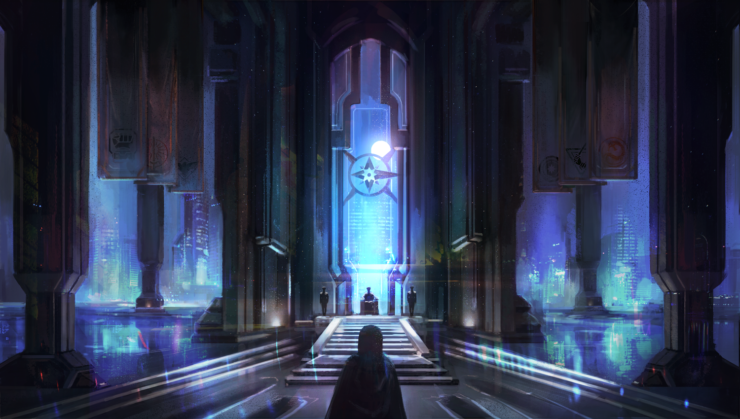
Ravenna has a large Twitter following, but, unlike artists such as Djamila Knopf, she makes her living through full time studio jobs. “I feel like it’s difficult for my work to be seen on Facebook. There’s less of a sharing culture there.” Twitter and Instagram, on the other hand, provide more opportunity for artists to build a community of fans that share their work. “With Instagram, people seem to have success when participating in monthly challenges with tags such as #inktober or #mermay. With Twitter, I believe people experience faster growth than on other social media platforms because it’s easier to share content with retweets, and people are more open to sharing and lifting up other creators in that space. I like Twitter because I feel seen on the platform.” A lot of positivity comes out of movements like #visiblewomen, #artistsontwitter, and #artvsartist, she said. “People love sharing work by their favourite creators. I feel like that helps everyone not only be seen, but also feel good about the work they do.”
Finding that balance between the rigours of being a professional, in-house concept artist and the relative freedom of being a freelance illustrator is important to Ravenna. Aspiring artists should “study harder and smarter, without compromising a healthy work/life balance,” she said. “Figure out what it is you love to do and go for it. The advice I hear from art directors all the time is, ‘Don’t do work if it’s only because you think it’s what people want to see.’ If you don’t like making the work, it’s not going to be fun, and it will show. If you enjoy the work and it’s good, people will come to you.”
Aidan Moher is the Hugo Award-winning founder of A Dribble of Ink, author of “On the Phone with Goblins” and “The Penelope Qingdom”, and a regular contributor to Tor.com and the Barnes & Noble SF&F Blog. Aidan lives on Vancouver Island with his wife and daughter, but you can most easily find him on Twitter @adribbleofink and Patreon.










